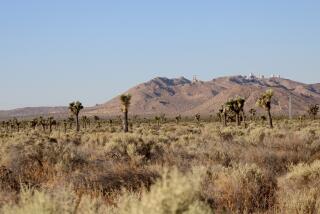Editorial: The government should expand protections for California’s deserts
Anyone who has driven through the California deserts — especially those who have wandered away from the freeways — has experienced the subtle majesty of vast open spaces, of the arroyos that wind back to jagged steep-sided mountains and of the magnificent plants and wildlife that thrive despite the low water, intense heat and relentless sun. The world tends to think of California nature in terms of beaches and redwoods and mountains, Big Sur and the Sierra Nevada, but the deserts are also part of who we are.
There are two movements afoot that would help expand conservation protections in the deserts while also allowing for development of solar, wind and geothermal energy. Both deserve support.
Sen. Dianne Feinstein has for years sought to expand federal protection to land that wasn’t included in the 1994 California Desert Protection Act, which covered nearly 7.6 million acres, elevated Death Valley and Joshua Tree to national parks and created the Mojave National Preserve. But her more recent legislation to establish two new national monuments and expand the Mojave National Preserve has gained no traction in a Congress that has been slow, to put it charitably, to designate additional conservation lands and parks. So Feinstein and conservation groups are petitioning President Obama to use his power under the Antiquities Act of 1906 to create the monuments, and to expand the covered areas even beyond her legislative proposal.
The president should grant her request. Feinstein has asked for creation of a Mojave Trails National Monument, which would connect the Mojave National Preserve with Joshua Tree, adding protections to federal lands that encompass sweeping vistas as well as habitats for such species as the desert tortoise and bighorn sheep. The monument would also include the Cadiz Valley, which contains dunes and the remnants of training grounds used by Gen. George Patton’s armored divisions before they deployed during World War II, and culturally and wildlife-rich areas in the Sacramento Mountains. Feinstein also has asked Obama to create a Sand to Snow National Monument, which would include 135,000 acres between Joshua Tree and the San Bernardino Mountains as well as the Black Lava Butte and Flat Top Mesa (holding 1,700 petroglyphs and several natural springs). And she wants the picturesque, habitat-heavy Castle Mountains, which were omitted from the 1994 Desert Protection Act because an active gold mine was located there, to be designated a national monument now that the mine has closed.
Meanwhile, the U.S. Bureau of Land Management is separately reviewing final requests for changes to its part of what is known as the Desert Renewable Energy Conservation Plan, an enormous project to allocate 10 million acres of federal land for recreation, conservation and renewable energy production. The plan sets aside 388,000 acres for solar, wind and geothermal projects, 5.3 million acres for conservation areas and 3.8 million acres for recreational use, including off-road vehicles. A second phase of the plan being developed by counties and cities for about 12.5 million acres under their jurisdiction is expected to designate even more public and private land for renewable energy development.
The Antiquities Act gives the president the power to “declare by public proclamation historic landmarks, historic and prehistoric structures, and other objects of historic or scientific interest” to be protected as national monuments. BLM officials decided that 800,000 acres didn’t clear that hurdle, nor would they be suitable for energy development, and they remain unallocated. Now conservation and wilderness groups want the BLM to reconsider some of the unallocated areas covering the Big Maria Mountains in Riverside County, Bristol Valley east of Joshua Tree National Park, and the Lower Centennial Flat between the Inyo National Forest and Death Valley. In addition to offering stunning vistas, those lands provide habitat for desert animals and plants and contain scattered Native American sites. The conservationists make a persuasive case that they should be protected.
The BLM land reviewers should give these areas a second, closer look. It makes sense for the government to be as inclusive as possible in protecting fragile desert lands.
Follow the Opinion section on Twitter @latimesopinion and Facebook
More to Read
A cure for the common opinion
Get thought-provoking perspectives with our weekly newsletter.
You may occasionally receive promotional content from the Los Angeles Times.










